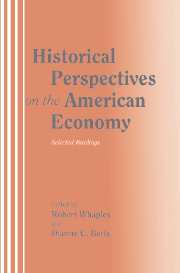Book contents
- Frontmatter
- Contents
- Acknowledgments
- Introduction to students
- Introduction to instructors
- Contributors
- I Introduction
- II Colonial and early national economy
- III Slavery and servitude
- 4 “The rise and fall of indentured servitude in the Americas: An economic analysis”
- 5 “The anatomy of exploitation”
- 6 “Slavery: The progressive institution?”
- 7 “Explaining the relative efficiency of slave agriculture in the antebellum South”
- IV The South since the Civil War
- V The rise of American industrial might
- VI Populism
- VII Women in the economy
- VIII The Great Depression
- Appendix: Basics of regression
- Glossary
- Name index
- Subject index
5 - “The anatomy of exploitation”
Published online by Cambridge University Press: 05 June 2012
- Frontmatter
- Contents
- Acknowledgments
- Introduction to students
- Introduction to instructors
- Contributors
- I Introduction
- II Colonial and early national economy
- III Slavery and servitude
- 4 “The rise and fall of indentured servitude in the Americas: An economic analysis”
- 5 “The anatomy of exploitation”
- 6 “Slavery: The progressive institution?”
- 7 “Explaining the relative efficiency of slave agriculture in the antebellum South”
- IV The South since the Civil War
- V The rise of American industrial might
- VI Populism
- VII Women in the economy
- VIII The Great Depression
- Appendix: Basics of regression
- Glossary
- Name index
- Subject index
Summary
Webster's Third New International Dictionary gives two definitions of personal exploitation. These are:
an unjust or improper use of another person for one's own profit or advantage;
utilization of the labor power of another person without giving a just or equivalent return.
Slaves were exploited in both of these senses. For the advantage of their masters, they were whipped, sold on the auction block, separated from loved ones, deprived of education, terrorized, raped, forced into prostitution, and worked beyond limits of human endurance. The labor power of slaves was also utilized without giving slaves an equivalent return. This aspect of their exploitation was most apparent in the case of hires. The man who rented a slave paid the full market value of the slave's services, but the slave received only part of that payment. The slave's income was the expenditure of the renter on his maintenance; the balance of the value produced by the slave went to the owner of the slave in the form of a rental fee.
While the existence of exploitation is beyond question, the extent of that exploitation is less clear. How frequent was the mean and improper use of slaves and how far did meanness go? How much of the income produced by slaves was expropriated from them?
The posing of these questions may seem irrelevant, even malicious. For many, it is enough merely to recognize the existence of 250 years of exploitation under slavery and to stress its horror.
- Type
- Chapter
- Information
- Historical Perspectives on the American EconomySelected Readings, pp. 141 - 176Publisher: Cambridge University PressPrint publication year: 1995



